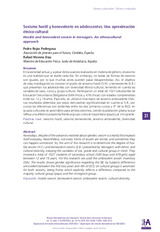Mostrar el registro sencillo del ítem
Sexismo hostil y benevolente en adolescentes. Una aproximación étnico-cultural
| dc.contributor.author | Rojas Pedregosa, Pedro | |
| dc.contributor.author | Moreno Díaz, Rafael | |
| dc.date.accessioned | 2018-11-12T12:20:14Z | |
| dc.date.available | 2018-11-12T12:20:14Z | |
| dc.date.issued | 2016 | |
| dc.identifier.issn | 1022-6508 | |
| dc.identifier.uri | http://hdl.handle.net/10396/17447 | |
| dc.description.abstract | En la sociedad actual, y a pesar de los avances realizados en materia de género, el sexismo es una realidad que se repite cada día. Sin embargo, no todas las formas de sexismo son iguales, por lo que muchas veces pueden pasar desapercibidas. Así, el objetivo de esta investigación es conocer el grado de sexismo hostil (S.H.) y benevolente (S.B.) que presentan los adolescentes con diversidad étnico-cultural, teniendo en cuenta las variables de sexo, curso y grupo cultural. Participaron un total de 1027 estudiantes de Educación Secundaria Obligatoria (549 chicos y 478 chicas) con edades comprendidas entre los 12 y 19 años. Para ello, se utilizó el Inventario de sexismo ambivalente (ISA). Los resultados obtenidos por sexos demuestran significatividad en cuanto al S.B.; por cursos las diferencias son evidentes entre los dos primeros cursos y 4º de la ESO; en grupos culturales es axiomático para ambos sexismos, siendo la población gitana la que refleja una diferencia explicita frente al grupo cultural mayoritario (payo) y al inmigrante. | es_ES |
| dc.description.abstract | Nowadays, despite of the advances realized about gender, sexism is a reality that repeats itself everyday. Nevertheless, not every forms of sexism are similar, and sometimes they can happen unnoticed. So, the aim of this research is to determine the degree of hostile sexism (H.S.) and benevolent sexims (S.B.) presented by teenagers with ethnic and cultural diversity, keeping the variables of sex, grade and cultural group in mind. They involved a total of 1027 students of secondary school (549 boys and 478 girls) aged between 12 and 19 years. For this research we used the ambivalent sexism inventory (ISA). The results shows gender significance regarding the SB; by Subjects differences are evident between the first two years and 4th of ESO; on cultural groups is axiomatic for both sexisms, being Roma which explicitly reflects a difference compared to the majority cultural group (payo) and the immigrant group. | es_ES |
| dc.format.mimetype | application/pdf | es_ES |
| dc.language.iso | spa | es_ES |
| dc.rights | https://creativecommons.org/licenses/by-nc-nd/4.0/ | es_ES |
| dc.source | Revista Iberoamericana de Educación 72 (1), 31-46 (2016) | es_ES |
| dc.subject | Sexismo hostil | es_ES |
| dc.subject | Sexismo benevolente | es_ES |
| dc.subject | Sexismo ambivalente | es_ES |
| dc.subject | Diversidad cultural | es_ES |
| dc.subject | Hostile sexism | es_ES |
| dc.subject | Benevolent sexism | es_ES |
| dc.subject | Ambivalent sexism | es_ES |
| dc.subject | Cultural diversity | es_ES |
| dc.title | Sexismo hostil y benevolente en adolescentes. Una aproximación étnico-cultural | es_ES |
| dc.title.alternative | Hostile and benevolent sexism in teenagers. An ethnocultural approach | es_ES |
| dc.type | info:eu-repo/semantics/article | es_ES |
| dc.relation.publisherversion | https://rieoei.org/RIE | es_ES |
| dc.rights.accessRights | info:eu-repo/semantics/openAccess | es_ES |

